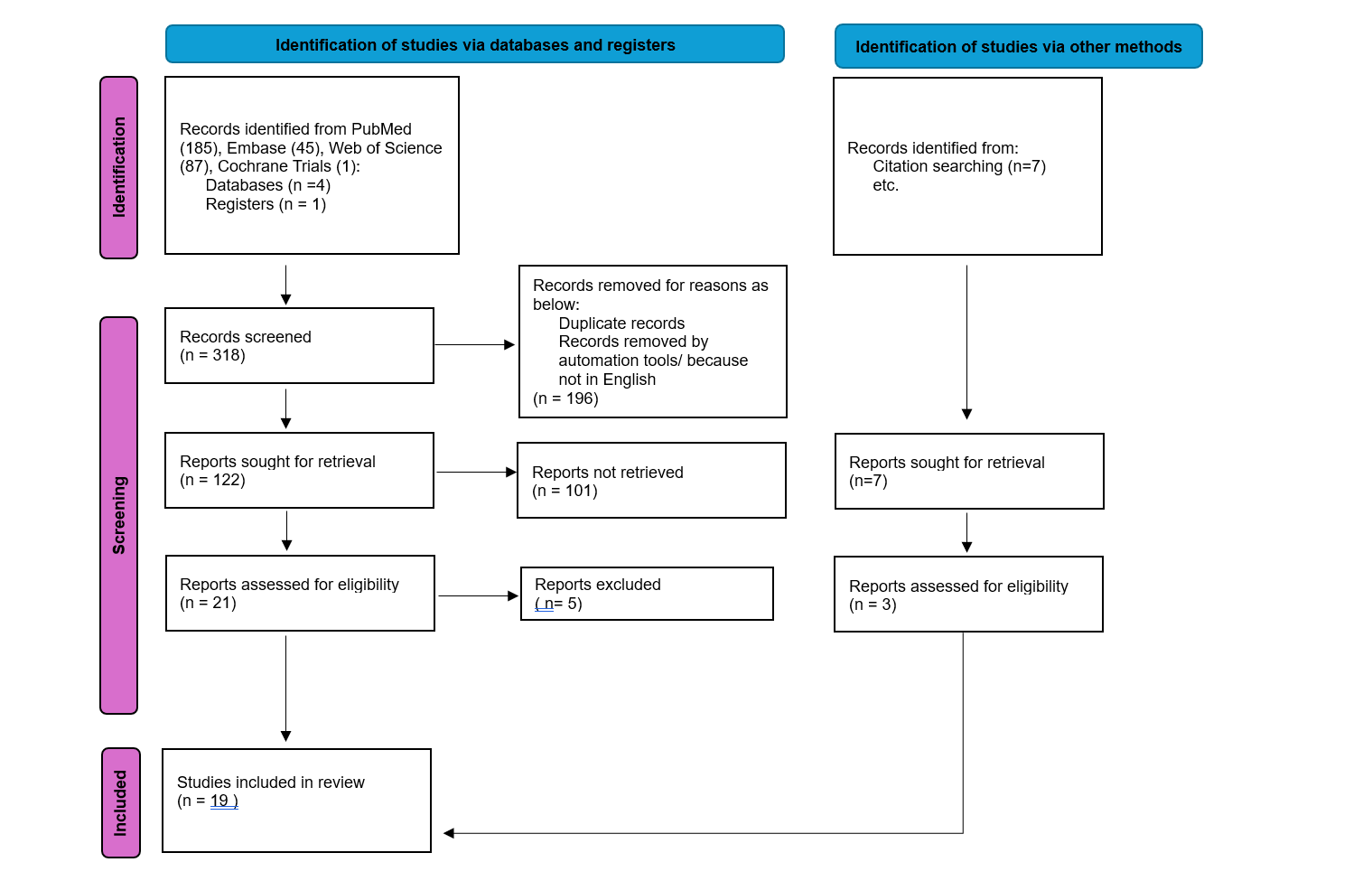Sunday Poster Session
Category: Biliary/Pancreas
P0091 - Pancreatic Cystic Lesions in Cystic Fibrosis: A Scoping Review
Sunday, October 26, 2025
3:30 PM - 7:00 PM PDT
Location: Exhibit Hall
- GN
Gomathy Nageswaran, MBBS (she/her/hers)
University of Arkansas for Medical Sciences
Little Rock, AR
Presenting Author(s)
Gomathy Nageswaran, MBBS1, Christine Hachem, MD, FACG2, John Erikson Yap, MD, MBA, FACG3
1University of Arkansas for Medical Sciences, Little Rock, AR; 2Intermountain Health, Salt Lake City, UT; 3University of Utah Health, Salt Lake City, UT
Introduction: Cystic fibrosis (CF) is associated with a spectrum of pancreatic abnormalities, including fibrofatty parenchymal replacement and cystic lesions, with almost a fivefold increased risk of pancreatic cancer. With the advent of CFTR modulator therapy and improved life expectancy, pancreatic manifestations such as cystic lesions are becoming more clinically relevant, particularly due to their potential to mimic or harbor malignancy. Here, we conducted a scoping review to characterize the types, presentations, and outcomes of pancreatic cystic lesions in individuals with cystic fibrosis (CF).
Methods: A comprehensive search was performed using the Population, Concept, and Context (PCC) framework across PubMed, Embase, Web of Science, and Cochrane Trials. From 318 identified studies, 122 were screened after removing duplicates and non-English publications. Twenty-one full-text articles were assessed, and 16 met the inclusion criteria. An additional 3 studies were included through manual citation search, yielding a total of 19 studies for final analysis (Figure 1).
Results: A total of 35 patients were reported across 18 case reports and 1 cohort study. The majority (66%) were female, with a mean age of 14 years (range: 9–56 years). The most common finding was pancreatic cystosis. Two cases each of intraductal papillary mucinous neoplasm (IPMN) and mucinous cystadenoma/cystadenocarcinoma were reported, as well as one case of a retention cyst. Cyst sizes varied, with the largest reaching 10 cm. Cystadenomas were associated with elevated CA 19-9 levels, while retention cysts showed elevated lipase. Most lesions were managed non-operatively with imaging surveillance, with only one case of malignant transformation (cystadenocarcinoma) that occurred after 13 years of follow-up. CF-related diabetes was reported in 11.4% of the patients, and pancreatic insufficiency in 20% of the patients. Data on duration and surveillance intervals, pancreatitis, or tobacco use were inconsistently reported across studies.
Discussion: This scoping review highlights the diverse pathology of pancreatic cystic lesions in CF, most of which appear benign and asymptomatic. Given the increasing lifespan of CF patients, awareness and surveillance of pancreatic cystic lesions is critical for early detection of potential malignancy.

Figure: PRISMA flow diagram showing selection of the included studies
Disclosures:
Gomathy Nageswaran indicated no relevant financial relationships.
Christine Hachem indicated no relevant financial relationships.
John Erikson Yap: Phathom Pharmaceutical – Speakers Bureau. Steris – Consultant.
Gomathy Nageswaran, MBBS1, Christine Hachem, MD, FACG2, John Erikson Yap, MD, MBA, FACG3. P0091 - Pancreatic Cystic Lesions in Cystic Fibrosis: A Scoping Review, ACG 2025 Annual Scientific Meeting Abstracts. Phoenix, AZ: American College of Gastroenterology.
1University of Arkansas for Medical Sciences, Little Rock, AR; 2Intermountain Health, Salt Lake City, UT; 3University of Utah Health, Salt Lake City, UT
Introduction: Cystic fibrosis (CF) is associated with a spectrum of pancreatic abnormalities, including fibrofatty parenchymal replacement and cystic lesions, with almost a fivefold increased risk of pancreatic cancer. With the advent of CFTR modulator therapy and improved life expectancy, pancreatic manifestations such as cystic lesions are becoming more clinically relevant, particularly due to their potential to mimic or harbor malignancy. Here, we conducted a scoping review to characterize the types, presentations, and outcomes of pancreatic cystic lesions in individuals with cystic fibrosis (CF).
Methods: A comprehensive search was performed using the Population, Concept, and Context (PCC) framework across PubMed, Embase, Web of Science, and Cochrane Trials. From 318 identified studies, 122 were screened after removing duplicates and non-English publications. Twenty-one full-text articles were assessed, and 16 met the inclusion criteria. An additional 3 studies were included through manual citation search, yielding a total of 19 studies for final analysis (Figure 1).
Results: A total of 35 patients were reported across 18 case reports and 1 cohort study. The majority (66%) were female, with a mean age of 14 years (range: 9–56 years). The most common finding was pancreatic cystosis. Two cases each of intraductal papillary mucinous neoplasm (IPMN) and mucinous cystadenoma/cystadenocarcinoma were reported, as well as one case of a retention cyst. Cyst sizes varied, with the largest reaching 10 cm. Cystadenomas were associated with elevated CA 19-9 levels, while retention cysts showed elevated lipase. Most lesions were managed non-operatively with imaging surveillance, with only one case of malignant transformation (cystadenocarcinoma) that occurred after 13 years of follow-up. CF-related diabetes was reported in 11.4% of the patients, and pancreatic insufficiency in 20% of the patients. Data on duration and surveillance intervals, pancreatitis, or tobacco use were inconsistently reported across studies.
Discussion: This scoping review highlights the diverse pathology of pancreatic cystic lesions in CF, most of which appear benign and asymptomatic. Given the increasing lifespan of CF patients, awareness and surveillance of pancreatic cystic lesions is critical for early detection of potential malignancy.

Figure: PRISMA flow diagram showing selection of the included studies
Disclosures:
Gomathy Nageswaran indicated no relevant financial relationships.
Christine Hachem indicated no relevant financial relationships.
John Erikson Yap: Phathom Pharmaceutical – Speakers Bureau. Steris – Consultant.
Gomathy Nageswaran, MBBS1, Christine Hachem, MD, FACG2, John Erikson Yap, MD, MBA, FACG3. P0091 - Pancreatic Cystic Lesions in Cystic Fibrosis: A Scoping Review, ACG 2025 Annual Scientific Meeting Abstracts. Phoenix, AZ: American College of Gastroenterology.
